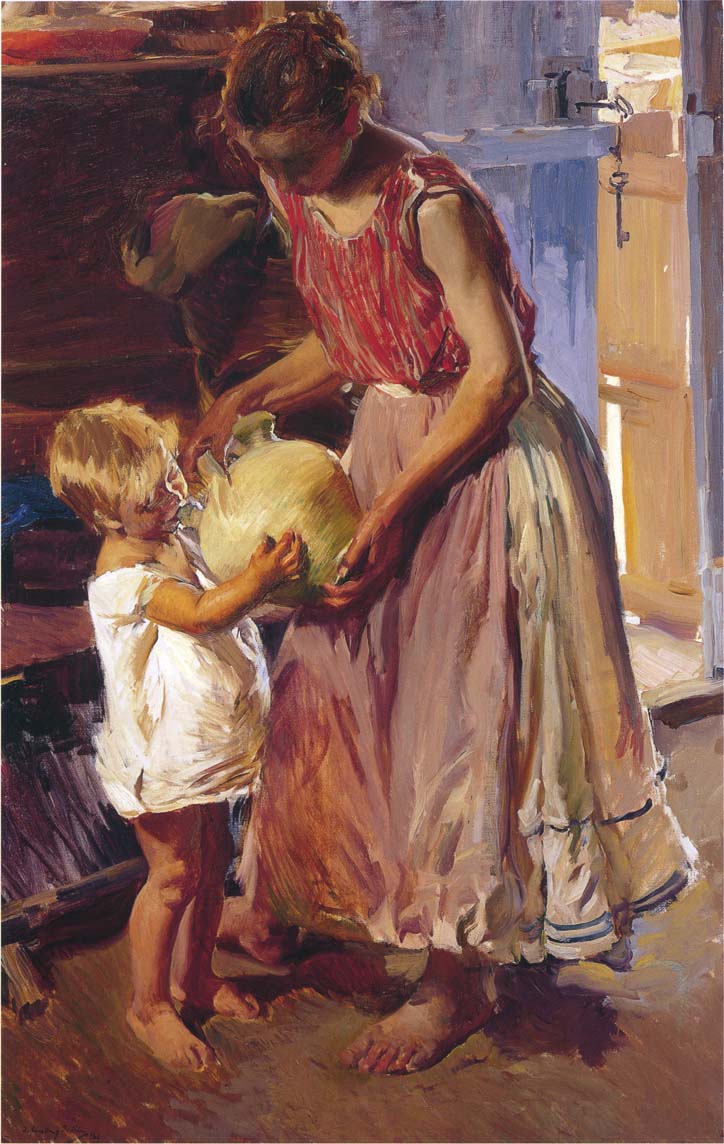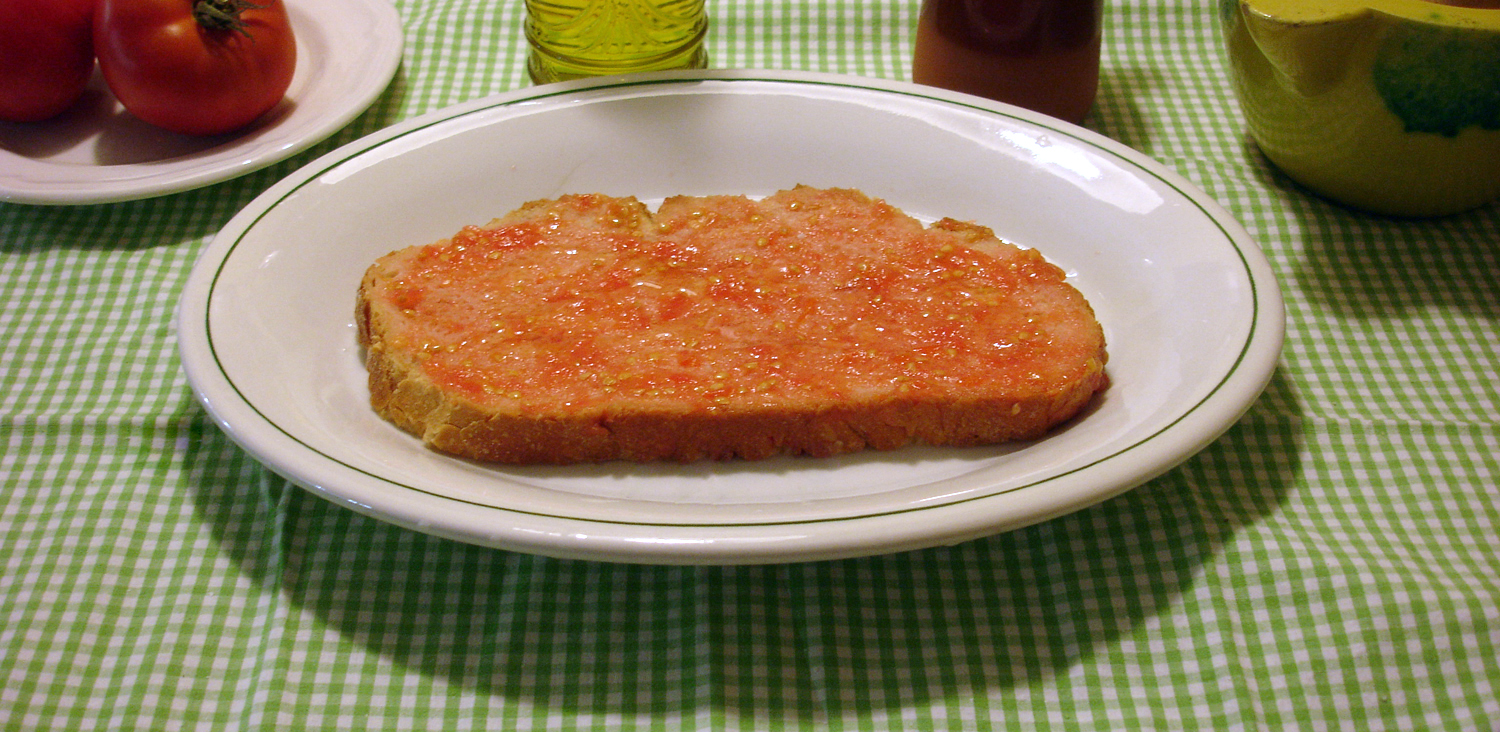|
Porron
A porrón ( ca, porró) is a traditional glass wine pitcher, which holds typical of Spain, originating in Catalonia, in northeastern Spain, and eventually spreading to other parts of Spain. This invention allows everyone to drink from the same utensil without touching it with their lips. It fosters communal drinking accompanying food, though it does require some skill to ensure the wine enters one's mouth and to keep it from spilling onto clothing. Some might say it resembles a cross between a wine bottle and a watering can. The top of the bottle is narrow and can be sealed off with a cork. Stemming upwards from the bottom of the pitcher is a spout that gradually tapers off to a small opening. It is shaped such that the wine stored inside it will have minimal contact with the air, while being ready to be used at all times. Until the mid-twentieth century it was very common in homes, but the tradition is now slowly being lost. The idea originated as a replacement to bota bags. Porron ... [...More Info...] [...Related Items...] OR: [Wikipedia] [Google] [Baidu] |
Càntir
A botijo, also called ''búcaro'', is a traditional porous clay container designed to contain water. The botijo is a typical element of Spanish culture and may vary in shape, color and material. The botijo has the property that once filled, it cools the water that it contains, acting as an evaporative cooler. The botijo has a wide belly and one or more mouths where it is filled and one or more outputs called ''pitón'' or ''pitorro'' to drink from. The ''búcaro de Indias'' is a special type, made of fragrant clay from Mexico, that was prized in Europe.https://www.metmuseum.org/art/collection/search/662163 Operation The operating principle of the botijo is as follows: the stored water is filtered through the pores of the clay and in contact with the outside dry environment (characteristic of Mediterranean climate), it evaporates, producing a cooling (2.219 kilojoules per gram of evaporated water). The key for cooling it, is by the evaporation of bleed water, as the water ev ... [...More Info...] [...Related Items...] OR: [Wikipedia] [Google] [Baidu] |
Pitcher (container)
In American English, a pitcher is a container with a spout used for storing and pouring liquids. In English-speaking countries outside North America, a jug is any container with a handle and a mouth and spout for liquid – American "pitchers" will be called jugs elsewhere. Generally a pitcher also has a handle, which makes pouring easier. Ewer is an older word for a pitcher or jug of any type, though tending to be used for a vase-shaped pitcher, often decorated, with a base and a flaring spout. The word is now unusual in informal English describing ordinary domestic vessels. A notable ewer is the America's Cup, which is awarded to the winning team of the America's Cup sailing regatta match. In modern British English, the only use of "pitcher" is when beer is sold by the pitcher in bars and restaurants, following the American style. Etymology The word ''pitcher'' comes from the 13th-century Middle English word ''picher'', which means earthen jug. The word ''picher'' is l ... [...More Info...] [...Related Items...] OR: [Wikipedia] [Google] [Baidu] |
Botijo
A botijo, also called ''búcaro'', is a traditional porous clay container designed to contain water. The botijo is a typical element of Spanish culture and may vary in shape, color and material. The botijo has the property that once filled, it cools the water that it contains, acting as an evaporative cooler. The botijo has a wide belly and one or more mouths where it is filled and one or more outputs called ''pitón'' or ''pitorro'' to drink from. The ''búcaro de Indias'' is a special type, made of fragrant clay from Mexico, that was prized in Europe.https://www.metmuseum.org/art/collection/search/662163 Operation The operating principle of the botijo is as follows: the stored water is filtered through the pores of the clay and in contact with the outside dry environment (characteristic of Mediterranean climate), it evaporates, producing a cooling (2.219 kilojoules per gram of evaporated water). The key for cooling it, is by the evaporation of bleed water, as the water ev ... [...More Info...] [...Related Items...] OR: [Wikipedia] [Google] [Baidu] |
Catalan Cuisine
Catalan cuisine is the cuisine from Catalonia. It may also refer to the shared cuisine of Northern Catalonia and Andorra, the second of which has a similar cuisine to that of the neighbouring Alt Urgell and Cerdanya '' comarques'' and which is often referred to as "Catalan mountain cuisine". It is considered a part of western Mediterranean cuisine. History There are several Catalan language cookbooks from the Middle Ages that are known to modern scholars. The ' (1520) was one of the most influential cookbooks of Renaissance Spain. It includes several sauce recipes made with ingredients such as ginger, mace powder ('), cinnamon, saffron Saffron () is a spice derived from the flower of ''Crocus sativus'', commonly known as the "saffron crocus". The vivid crimson stigma (botany), stigma and stigma (botany)#style, styles, called threads, are collected and dried for use mainly ..., cloves ('), wine and honey. '' Salsa de pagó'' took its name from the peacock ( ca, el ... [...More Info...] [...Related Items...] OR: [Wikipedia] [Google] [Baidu] |
Wine Tasting
Wine tasting is the sensory examination and evaluation of wine. While the practice of wine tasting is as ancient as its production, a more formalized methodology has slowly become established from the 14th century onward. Modern, professional wine tasters (such as sommeliers or buyers for retailers) use a constantly evolving specialized terminology which is used to describe the range of perceived flavors, aromas and general characteristics of a wine. More informal, recreational tasting may use similar terminology, usually involving a much less analytical process for a more general, personal appreciation. Results that have surfaced through scientific blind wine tasting suggest the unreliability of wine tasting in both experts and consumers, such as inconsistency in identifying wines based on region and price. History The Sumerian stories of Gilgamesh in the 3rd millennium BCE differentiate the popular beers of Mesopotamia, as well as wines from Zagros Mountains or Lebanon. In ... [...More Info...] [...Related Items...] OR: [Wikipedia] [Google] [Baidu] |
Wine Accessory
Wine accessories are things that may be used in the storage or serving of wine. Wine accessories include many items such as wine glasses, corkscrews, and wine racks. Glasses Wine glasses are a type of glass stemware that are used to drink and taste wine from. Selection of a particular wine glass for a wine style is important, as the glass shape can influence its perception. Bottle openers Wine bottle openers are required to open wine bottles that are stoppered with a cork. They are slowly being supplanted by the screwcap closure. There are many different inceptions of the wine bottle opener ranging from the simple corkscrew, the screwpull lever, to complicated carbon dioxide driven openers. The most popular is the wine key, sommelier knife or "waiter's friend" which resembles a pocket knife and has a small blade for cutting foil and a screw with a bottle brace. Wine poppers are another means of opening wine. A hollow spike is driven through the cork of a bottle. A cartri ... [...More Info...] [...Related Items...] OR: [Wikipedia] [Google] [Baidu] |
Briq
A Briq, Ibrik or Brik ( ar, برق) is an ancient teapot and pitcher traditionally used by the inhabitants of Lebanon and Syria to prepare and drink tea or water. It is a pot and handle with an unconventional spout that allows liquid to be consumed easily with no receptacle and tea to be mixed effectively and conveniently. It is traditionally earthenware, however glass briqs are also commo Use The briq was historically carried around by people to quench thirst as its design is efficient and easy to use. Sharing and drinking tea with acquaintances and guests is common practice within Lebanese and Syrian culture and it would not be uncommon to share a tea in a briq with potential business customers as a gesture of good will. The lips do not touch the spout whilst drinking and this is especially important and hygienic as it is usually shared between several people. History As there is recordings of briqs being used in Lebanon between 1050 and 850 BC, we know briqs were around at t ... [...More Info...] [...Related Items...] OR: [Wikipedia] [Google] [Baidu] |
Catalan Language
Catalan (; autonym: , ), known in the Valencian Community and Carche as '' Valencian'' (autonym: ), is a Western Romance language. It is the official language of Andorra, and an official language of three autonomous communities in eastern Spain: Catalonia, the Valencian Community, and the Balearic Islands. It also has semi-official status in the Italian comune of Alghero. It is also spoken in the Pyrénées-Orientales department of France and in two further areas in eastern Spain: the eastern strip of Aragon and the Carche area in the Region of Murcia. The Catalan-speaking territories are often called the or "Catalan Countries". The language evolved from Vulgar Latin in the Middle Ages around the eastern Pyrenees. Nineteenth-century Spain saw a Catalan literary revival, culminating in the early 1900s. Etymology and pronunciation The word ''Catalan'' is derived from the territorial name of Catalonia, itself of disputed etymology. The main theory suggests that ... [...More Info...] [...Related Items...] OR: [Wikipedia] [Google] [Baidu] |
Homage To Catalonia
''Homage to Catalonia'' is George Orwell's personal account of his experiences and observations fighting in the Spanish Civil War for the POUM militia of the Republican army. Published in 1938 (about a year before the war ended) with little commercial success, it gained more attention in the 1950s following the success of Orwell's better-known works '' Animal Farm'' (1945) and ''Nineteen Eighty-Four'' (1949). Covering the period between December 1936 and June 1937, Orwell recounts Catalonia's revolutionary fervor during his training in Barcelona, his boredom on the front lines in Aragon, his involvement in the interfactional May Days conflict back in Barcelona on leave, his getting shot in the throat back on the front lines, and his escape to France after the POUM was declared an illegal organization. The war was one of the defining events of his political outlook and a significant part of what led him to write in 1946, "Every line of serious work that I have written since 19 ... [...More Info...] [...Related Items...] OR: [Wikipedia] [Google] [Baidu] |
George Orwell
Eric Arthur Blair (25 June 1903 – 21 January 1950), better known by his pen name George Orwell, was an English novelist, essayist, journalist, and critic. His work is characterised by lucid prose, social criticism, opposition to totalitarianism, and support of democratic socialism. Orwell produced literary criticism, poetry, fiction and polemical journalism. He is known for the allegorical novella '' Animal Farm'' (1945) and the dystopian novel '' Nineteen Eighty-Four'' (1949). His non-fiction works, including '' The Road to Wigan Pier'' (1937), documenting his experience of working-class life in the industrial north of England, and '' Homage to Catalonia'' (1938), an account of his experiences soldiering for the Republican faction of the Spanish Civil War (1936–1939), are as critically respected as his essays on politics, literature, language and culture. Blair was born in India, and raised and educated in England. After school he became an Imperial policeman ... [...More Info...] [...Related Items...] OR: [Wikipedia] [Google] [Baidu] |


.jpg)





